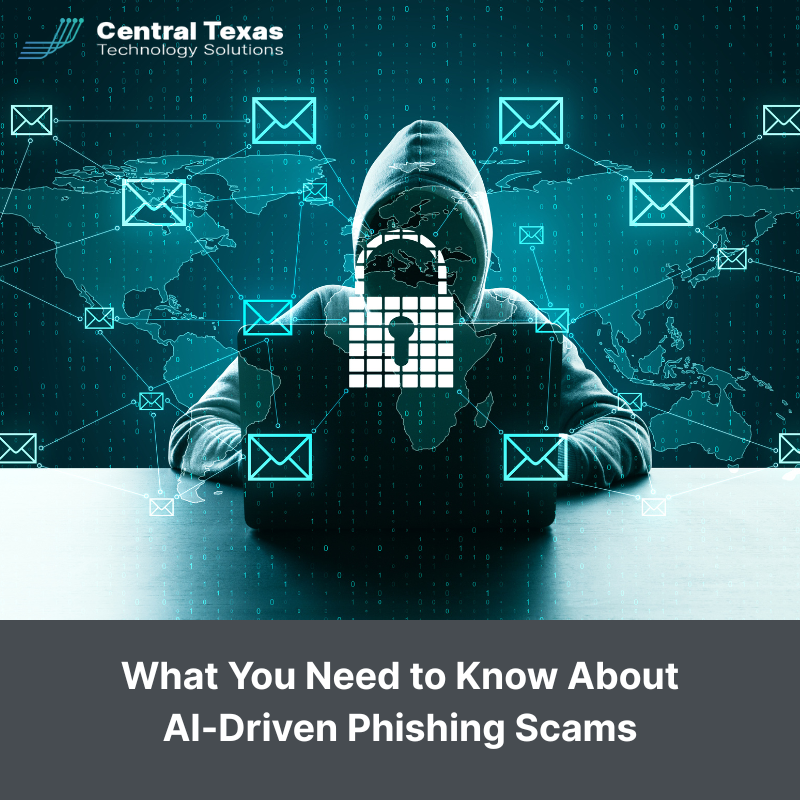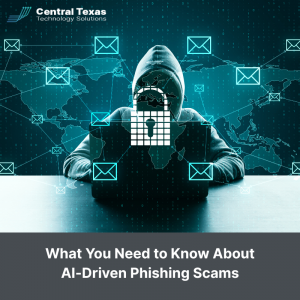
 Cybercriminals are no longer relying on clunky, error-filled emails to trick employees into clicking malicious links. Today, thanks to generative AI, phishing scams have become highly targeted, professional-looking, and dangerously effective. These AI-driven phishing scams are engineered to mimic your team’s tone, style, and even specific business details, making them far more believable than traditional attacks.
Cybercriminals are no longer relying on clunky, error-filled emails to trick employees into clicking malicious links. Today, thanks to generative AI, phishing scams have become highly targeted, professional-looking, and dangerously effective. These AI-driven phishing scams are engineered to mimic your team’s tone, style, and even specific business details, making them far more believable than traditional attacks.
For business leaders in Austin and across Central Texas, this evolution in cybercrime poses a serious threat. If your employees can’t spot a fake email, your company’s data, finances, and reputation could be at risk.
How AI-Driven Phishing Scams Are Changing the Game
The rise of generative AI has lowered the barrier to entry for cybercriminals. It allows attackers to craft realistic, customized messages in minutes instead of hours. These aren't just spam blasts. They are laser-targeted emails written in natural, convincing language.
What Makes AI-Driven Phishing So Dangerous?
- Personalization at Scale: AI tools can scrape data from websites, social media, and business directories to tailor emails for each employee.
- Authentic Voice and Branding: Emails match your internal communication style and visual branding, reducing suspicion.
- Speed and Volume: Bad actors can launch hundreds of personalized campaigns instantly, making detection harder and response time shorter.
- Bypassing Filters: Many AI-generated emails can bypass traditional spam filters, landing directly in your team’s inboxes.
In short, what once looked suspicious now looks like everyday communication from a trusted colleague.
AI-Driven Phishing Scams in Action
Imagine this: your bookkeeper receives an email that looks exactly like a message from your CFO. The signature, logo, and tone are spot-on. It asks for a wire transfer to a familiar vendor. The only problem? It’s fake, and the money is going straight to a cybercriminal.
Or picture your IT team getting an urgent password reset request from someone who appears to be your office manager. Without a second thought, they click. Just like that, your network is compromised.
These are not hypotheticals. These are real-world examples of how businesses across Texas are being targeted every day.
How Your Business Can Fight Back
To protect your organization against these evolving threats, you’ll need a layered strategy that blends technology with employee training.
Here’s how to start:
- Educate Your Team
- Train employees to recognize phishing attempts, especially those with emotional triggers like urgency or fear.
- Conduct regular simulations to build confidence and keep awareness high.
- Strengthen Email Security
- Use AI-based email filtering tools that detect subtle anomalies in writing style, subject lines, and sender behavior.
- Integrate security with your broader cybersecurity strategy for a more complete defense.
- Encourage Vigilant Behavior
- Build a culture where reporting suspicious emails is celebrated, not punished.
- Empower staff to verify requests, especially for wire transfers, credentials, or sensitive files.
- Set Clear Protocols
- Develop a chain of verification for high-risk requests.
- Ensure employees know who to contact when something feels off.
Why Central Texas Businesses Are Especially at Risk
Austin’s business community thrives on innovation, rapid growth, and collaboration. That same openness can create vulnerabilities. Fast-growing teams often onboard new employees quickly, and digital communication is the norm. AI-driven phishing scams exploit that environment.
At CTTS, we help organizations like yours stay one step ahead of cybercriminals. Our advanced threat protection tools, employee training programs, and 24/7 monitoring services give you the edge you need in today’s cybersecurity landscape.
Don’t Wait Until It’s Too Late
The sophistication of AI-driven phishing scams will only increase. The best time to prepare your team and upgrade your defenses is now, not after you’ve experienced a breach.
CTTS can help you build a security-first culture, implement next-gen tools, and reduce your risk. Your business deserves more than reactive protection. Let’s put a proactive plan in place.
FAQs About AI-driven Phishing Scams
1. How are AI-driven phishing scams different from traditional phishing emails?
Traditional phishing relies on volume and generic messages. AI-driven phishing uses machine learning to craft personalized, believable messages based on your company's language, structure, and online presence.
2. Can AI help defend against these threats, too?
Yes. Many modern email security platforms use AI to analyze message patterns, spot anomalies, and flag suspicious content in real-time.
3. What’s the most important step to take right now?
Start with employee education. Your staff is your first line of defense. Combine that with AI-enabled email filtering and a clear internal response plan to reduce your risk.
Contact CTTS today for IT support and managed services in Austin, TX. Let us handle your IT so you can focus on growing your business. Visit CTTSonline.com or call us at (512) 388-5559 to get started!
